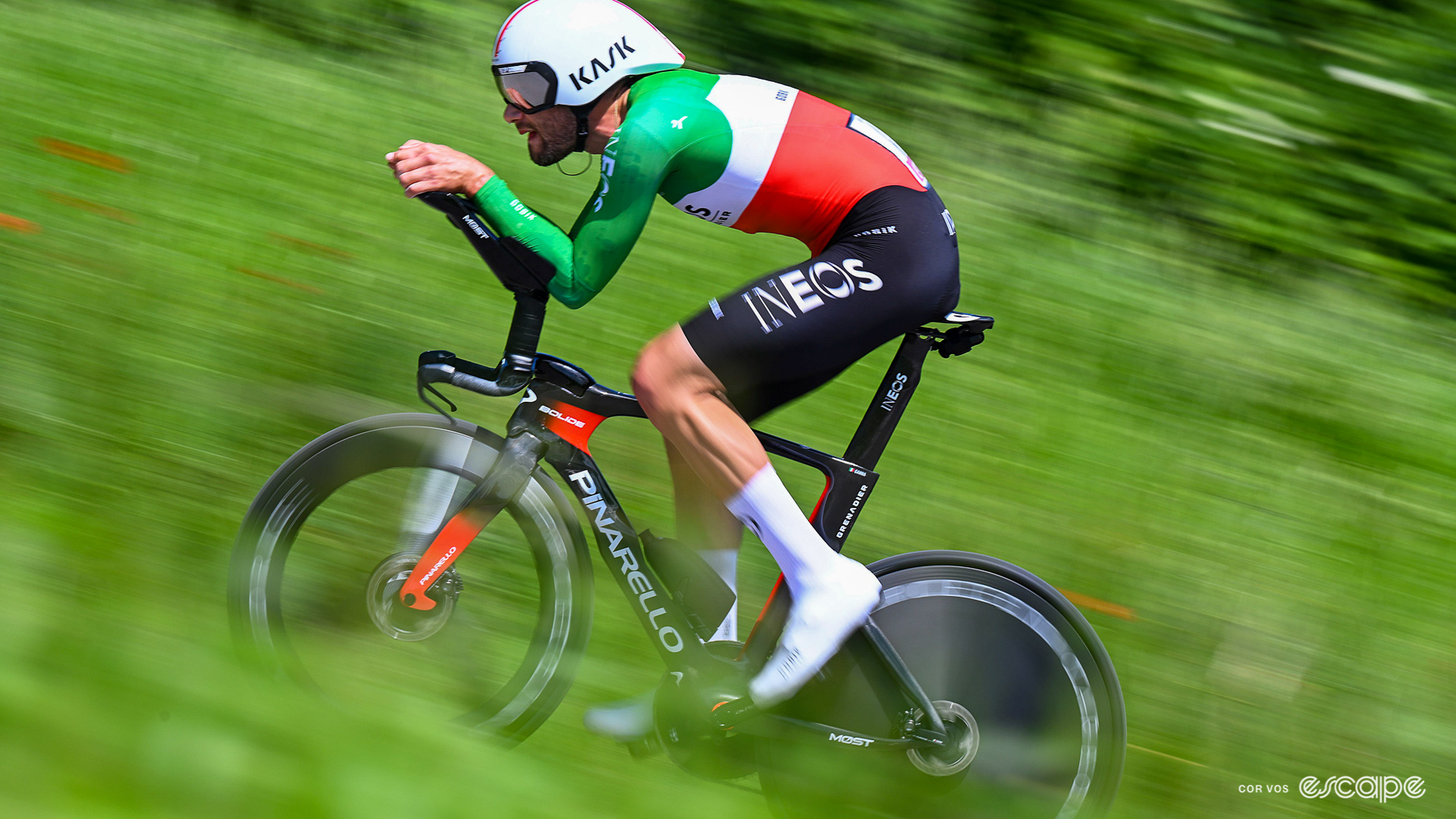A long, flat time trial with an uphill finish presents quite the drivetrain optimisation conundrum. On the one hand, the best testers want large 1X chainrings (think 58, 60, or even bigger tooth counts) for maximum drivetrain and aerodynamic efficiency on the fast flat section, but that setup will leave the rider over-geared for the climb to the finish.
So, with spreadsheets at the ready, most teams set about calculating answers to the 1X or 2X, bike change or no bike change, and best compromise chainring questions. Most teams that is, except Ineos Grenadiers who have asked: “how do we have both … without a bike change.”
The answer to that “have your cake and eat it” drivetrain question for Ineos is to pair 66- and 68-tooth chainrings with a Classified Powershift hub, a two-speed internal geared rear hub offering the benefits of a 2X drivetrain combined with the simplicity, or in this case aero gains, of a 1X setup.
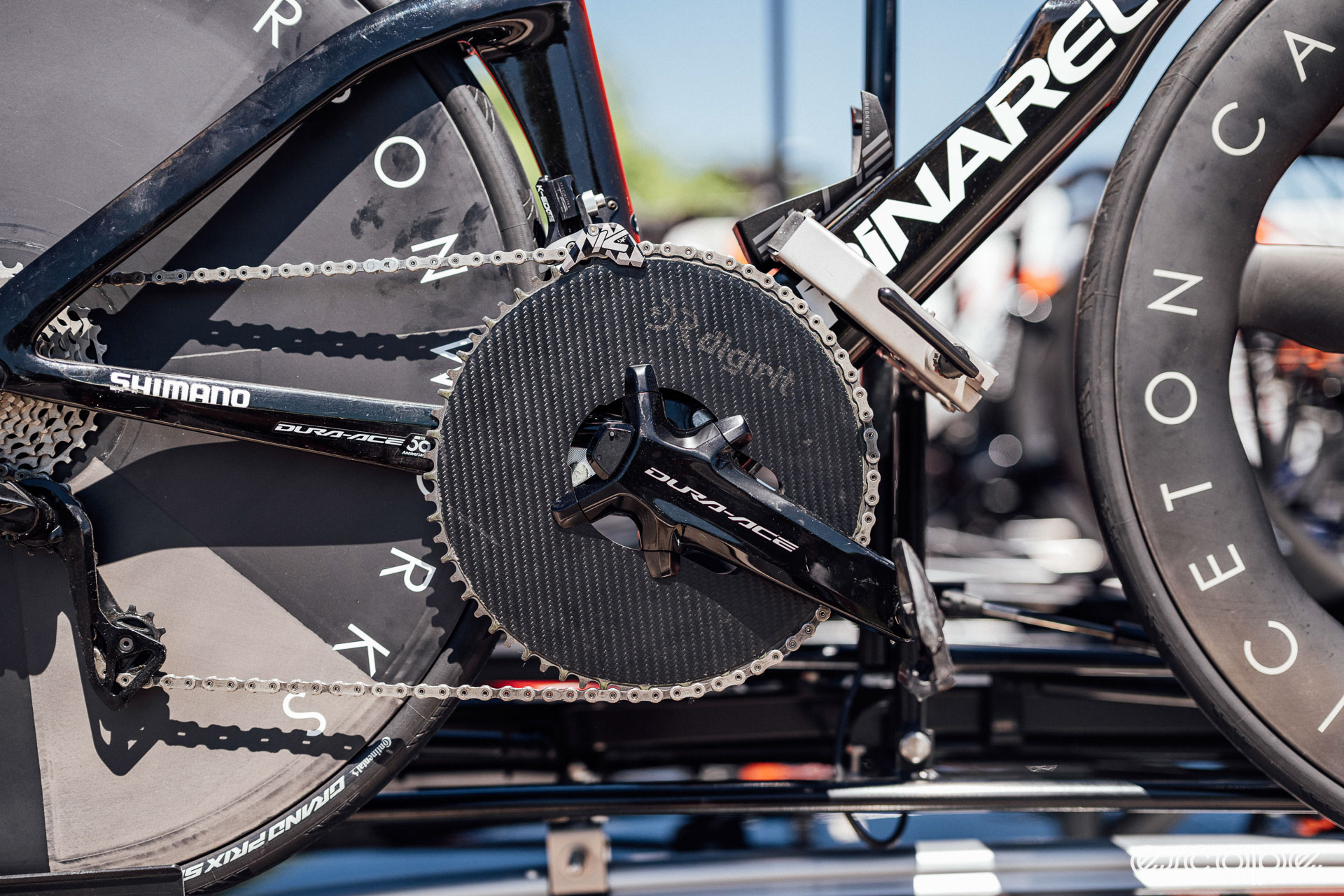
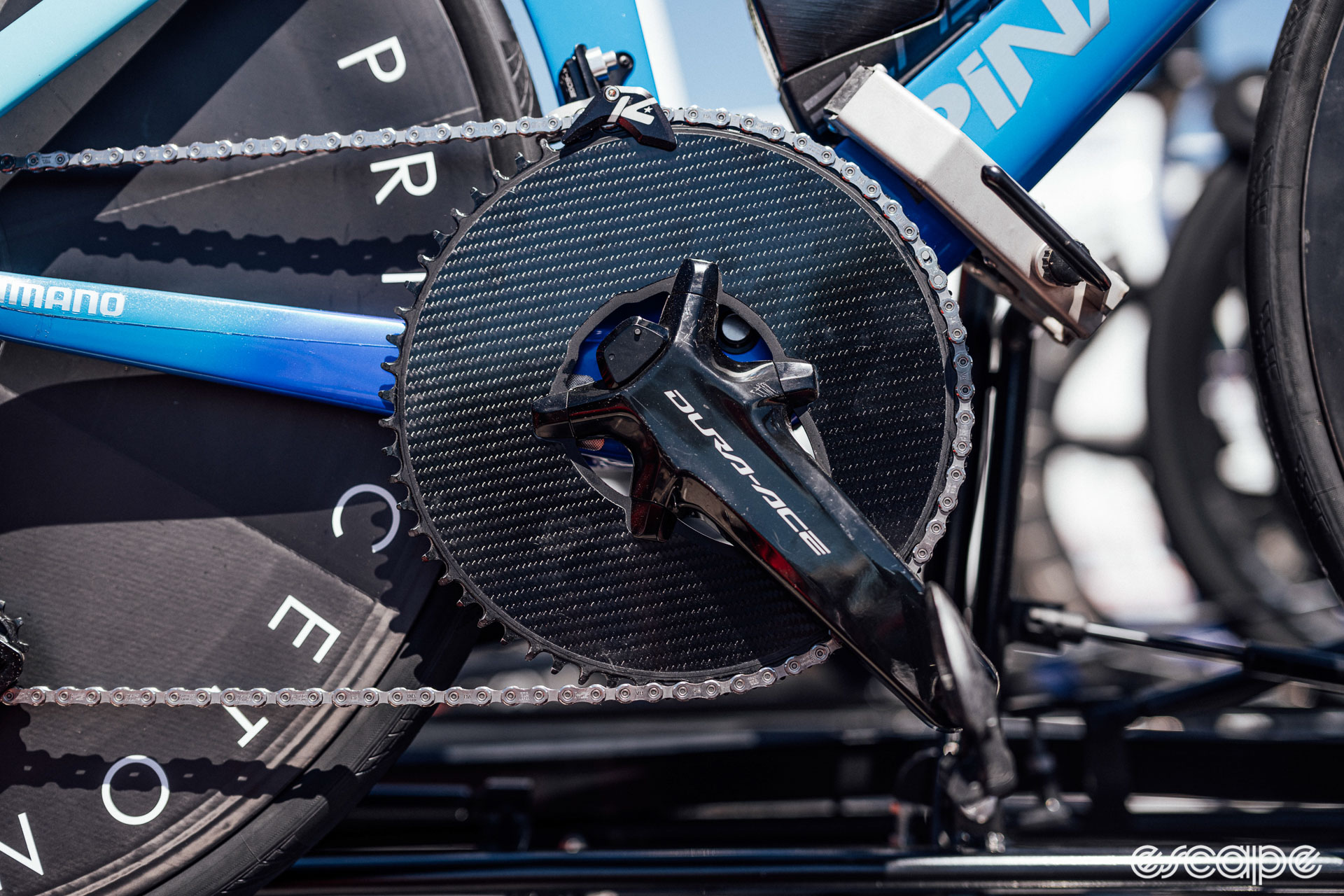
Looking at the specifics of today’s TT course. At 40.6 km, it’s a lengthy one, and with that final 6.6 km, 4.1% climb to the finish, it will prove challenging both physically and in managing pacing strategies. The climb features pitches up to 11% in the opening kilometre, but long stretches between 1-3% drag down the overall average gradient. That means, excluding that opening 1-1.5 km where the steep gradients and lower speeds may mean a lightweight road bike could be faster, a time trial bike will be significantly quicker on the fast, mostly false flat, final 5 km to the finish line. Riders will likely hit 40 km/h+ on these sections, swinging the advantage well and truly back to an aero TT bike and position. When combined with the time taken to change bikes before or on the climb, it would almost certainly prove slower to change onto a road bike.
But that’s only true if the TT bike is equipped with gearing to allow the rider to get over that initial steep section efficiently and certainly without walking. Lean too far into optimising the drivetrain for the flat sections and the rider is practically forced to do a bike change, but optimising for that 1.5 km of steep climbing effectively compromises the setup for the other 38 km of the stage.
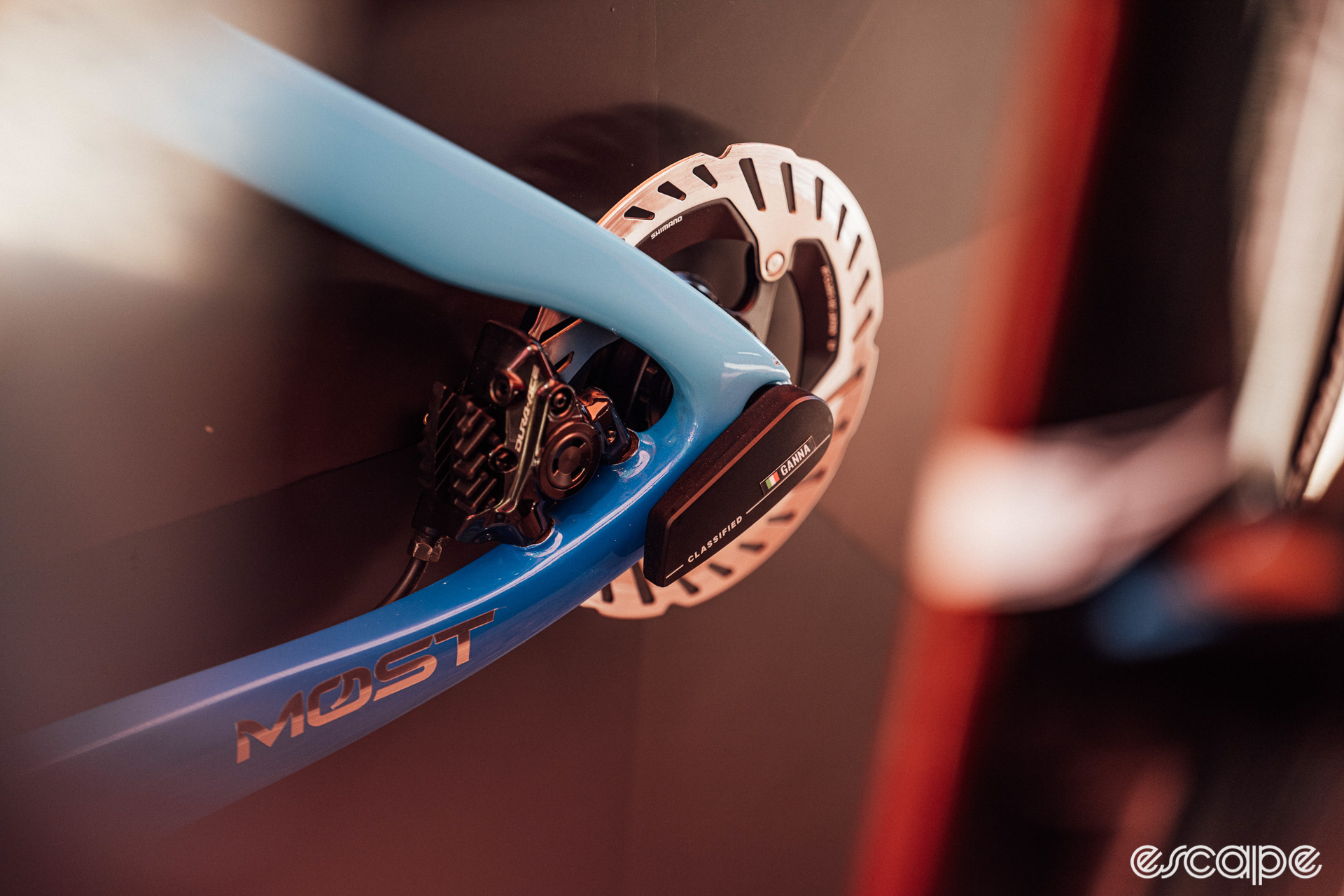
Hence, the genius of opting for a Powershift-equipped disc wheel. The Ineos riders not only have the correct gearing for both flat and uphill but also eliminate the question of to bike change or not to bike change. It also all but answers the 1X or 2X question, as we’ll see later.
Our own Dave Rome reviewed the Classified PowerShift system last year, and I raced it along with a 60-tooth chainring on an “optimised Cannondale SuperSix Evo” at the Ras Tailteann stage race last year. Victor Campanaerts of Lotto Dstny and some Uno-X Mobility riders have also raced with the Powershift hub in professional road races, including last year’s Omloop Het Nieuwsblad and Tour de Hongrie. But Ineos represents the first use in a time trial, turning to the system for today’s Giro stage in the hope of unlocking a flat and uphill optimised setup in one-time trial bike.
How to have cake?
There’s a lot to unpack here and clearly a lot of preparation work has happened prior to today’s stage to make this setup a possibility. Ineos, as we all know, race Pinarello bikes with Shimano Dura-Ace groupsets and wheels. For time trial stages, they typically swap out those Dura-Ace wheels for Princeton Carbon Works' (PCW) rear discs and front trispoke wheels.
Today, several Ineos riders lined up for their time trials with a new PCW Blur disc, including said Classified rear hub. That Classified hub gives riders a 1:1 gear ratio when “locked out” thus acting no different to a normal rear hub. But when ”unlocked” through an on/off dedicated shifter button mounted to the handlebars, the internal planetary gear in the hub creates a 1:0.686 gear (rounded up to .7 for simplicity). In simpler terms, think of that hub gear as the equivalent of an effective inner chainring roughly .7 the size of the actual front chainring.

The addition of the Classified hub means Ineos riders can equip their bikes with these huge 66- and 68-tooth chainrings for the fast and flat sections and hit the Classified Powershift button as they hit the climb to engage the equivalent of a much more manageable 46.2 or 47.6-tooth effective chainring. Furthermore, the Powershift allows for shifting under load and eliminates the possibility of a bodged front derailleur shift (and the dropped chain that might come with it) at a critical moment in the race.
But adding that Classified hub into a full monocoque disc is much more challenging than simply lacing it into a standard rim with some new spokes.
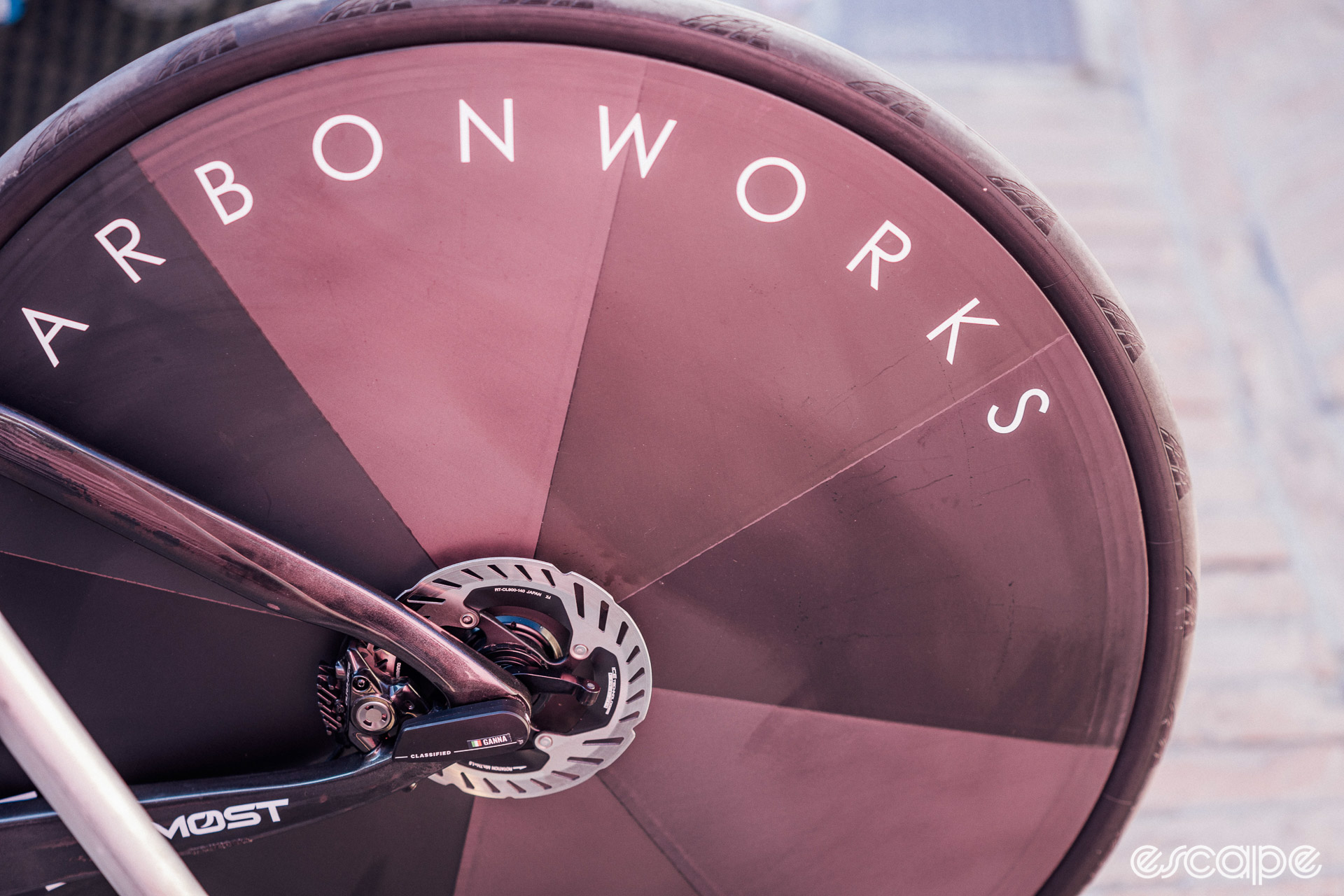
Integrating the Classified hub into a full monocoque disc is no small feat. Princeton Carbon Works founder, Harrison Macris, shared with Escape Collective that the wheel is not just an addition to their existing disc, but an entirely new offering, because the Powershift hub requires a specific hub shell to house the planetary gear internals.
While many wheel manufacturers are now adding the Powershift shell to their wheels, PCW went a step further and designed its own hub shell with proprietary outer dimensions matched to Classified-specific internal dimensions. This new hub shell is then permanently bonded to a mating hole in the disc side walls.
Those side walls are also different; in fact, practically all of the rim is new in some minor way. The updates are based on learnings taken from the two successful Hour Record attempts Princeton worked on with Filippo Ganna and Dan Bigham and include a more lenticular-shaped non-drive-side rim wall, some subtle smoothing to the drive-side profile, and an increase in hook-to-hook width.
That new wheel will be available with a Classified compatible or standard hub shell in the coming months.
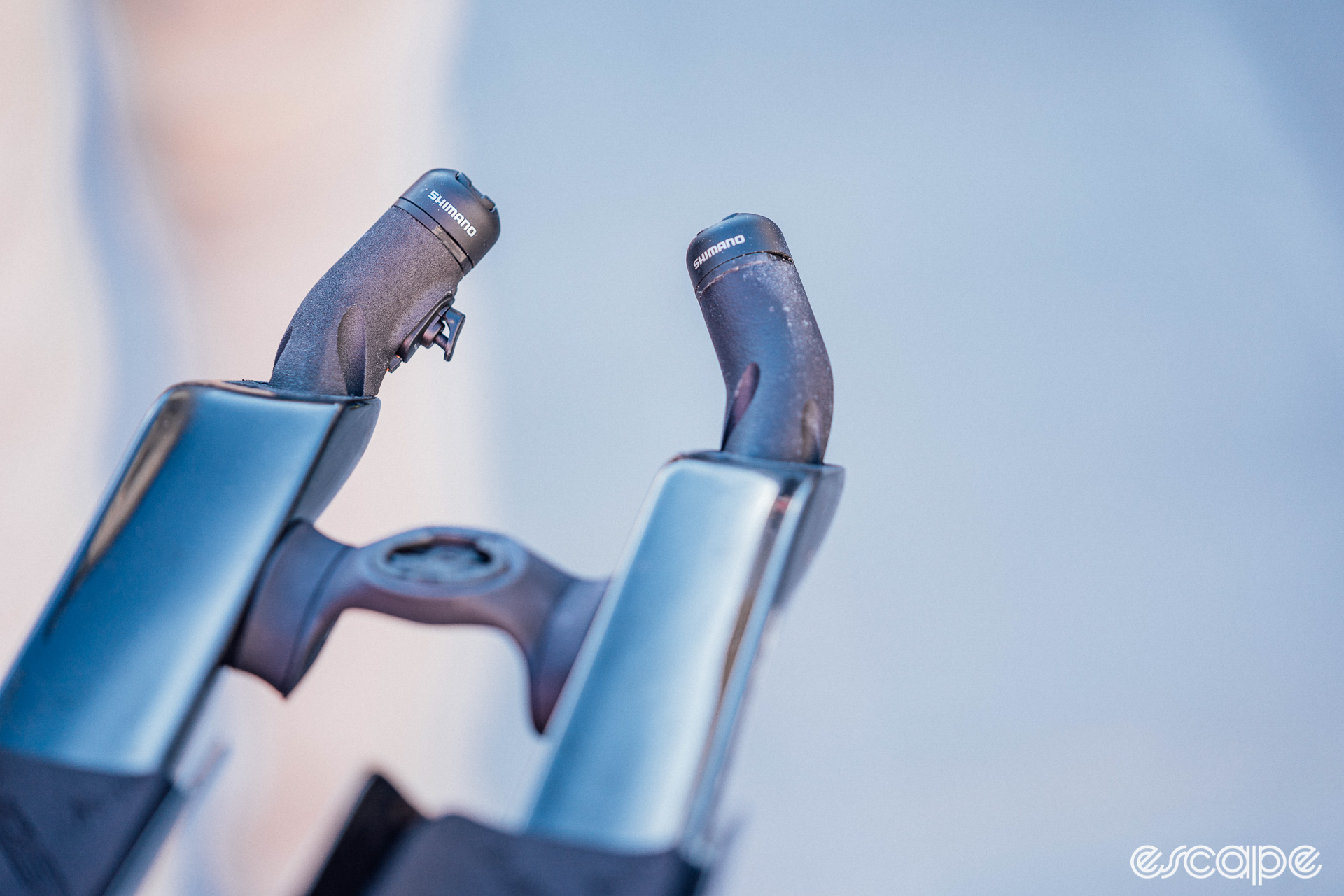

How to eat cake?
The upshot of all that is that Ineos can achieve optimal (or close to it) gearing for both the flat and uphill sections of the time trial in a single 1X setup TT bike. While the question of weight for the uphill section remains, this hub change all but eliminates the drivetrain optimisation problem. And that’s presumably where Dan Bigham’s famous spreadsheet comes in.
With Ganna and GC hope Geraint Thomas on the team, there is little doubt Ineos has done its homework in assessing the pros and cons of running the Classified setup. We have covered the pros, but switching to a Powershift hub is not without some compromises.
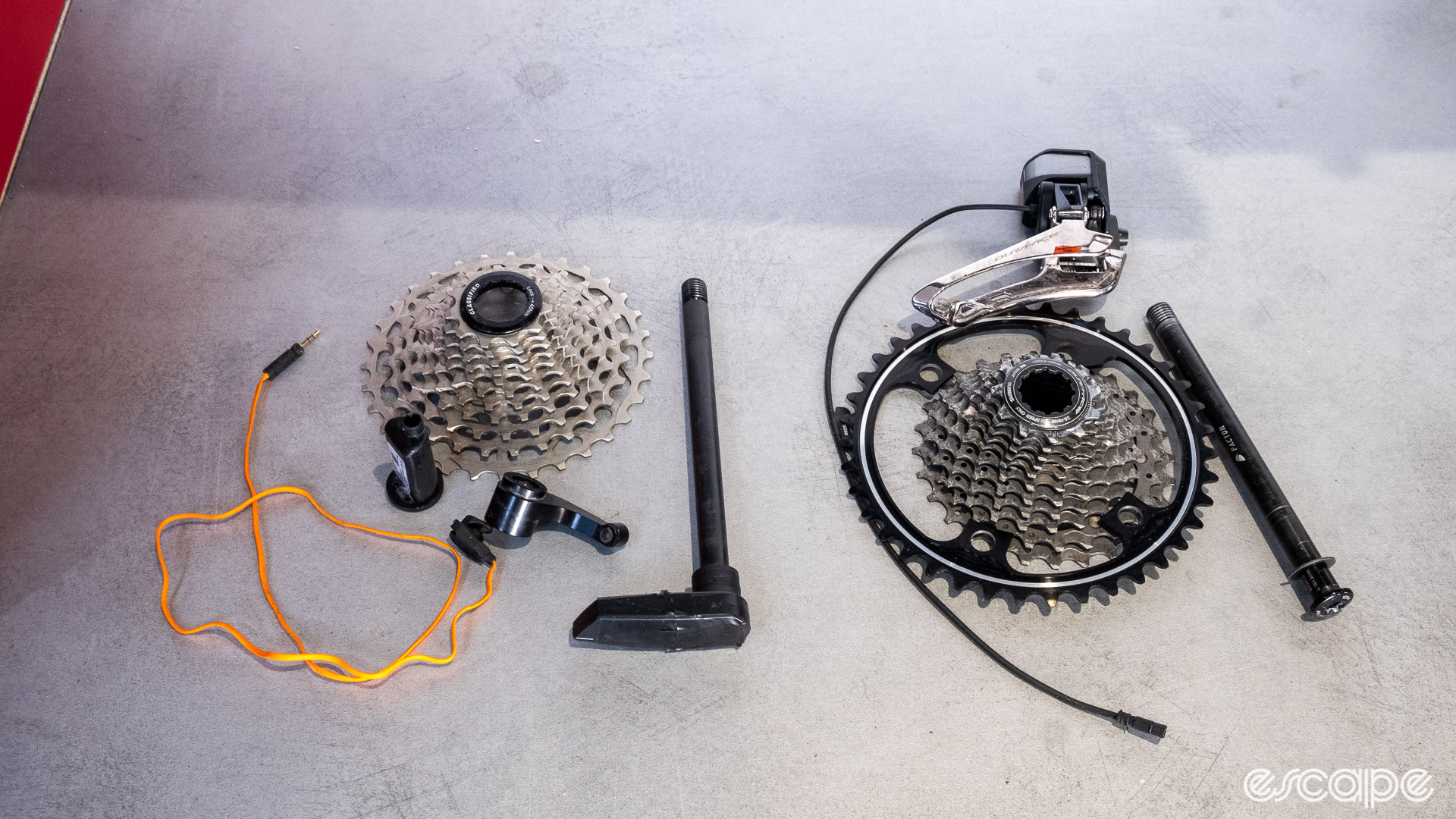
Classified claims there is a net weight saving to a bike equipped with its Powershift system versus the same bike with a standard hub, 2X chainring, and front derailleur setup. While this is possible, we suspect an apples-to-apples comparison of Ineos’s TT bikes would show a slight weight increase for the Powershift-equipped bike. This is definitely the case if compared to a 1X equipped TT bike, but realistically, that is not a fair comparison because anywhere a rider would need the Powershift, they would also need a 2X setup.
Then there is the drivetrain losses question that has plagued Classified since it unveiled its planetary gear system. There are practically zero additional losses versus a standard high-end drivetrain when running the Classified hub in the “locked” (ie. large chainring) position, but some have speculated there is perhaps some additional friction when running the unlocked gear.
Classified claims its system can eliminate cross-chaining losses, and while it does offer an option to shift the hub gear and maintain a straighter chain line, this doesn’t quite run true to real-world usage when applied to a TT bike setup where riders want to use the Classified system to maximise front chainring size. Increasing that chainring size also increases the size of the .7 effective inner chainring from the hub gearing and, as such, means the rider will still need to shift the rear derailleur and likely end up cross-chaining just as much on steeper inclines. That’s not to say Classified is wrong; it’s just a use-case benefit for the same system.
That said, if there are losses, Classified claims they are practically zero and has published a white paper to back up this claim, saying that the system is most efficient in the “unlocked” gear on steep climbs where speed is low and load is high. In other words: it's most efficient in the only place Ineos riders are likely to use it today.
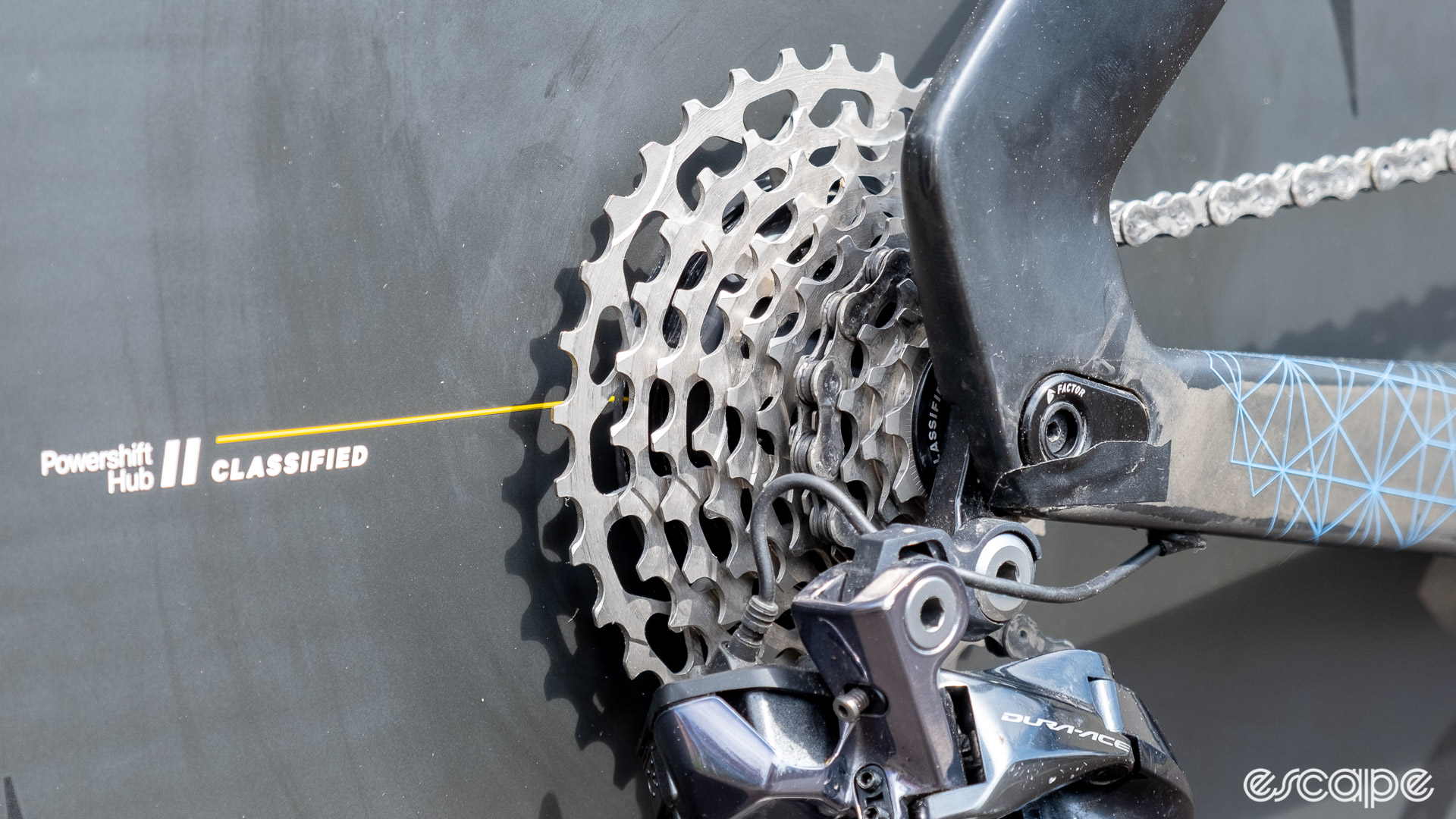
The Powershift hub also requires a dedicated cassette. As such, Ineos will not be running the Shimano 12-speed cassette that works best with the rest of the Dura-Ace drivetrain and shifting may not be quite as slick. The shifting on the Classified cassette is perfectly functional; again, I did an entire stage race on it last year. But t’s just not quite as slick as a complete Shimano drivetrain, something Ineos had already dropped given they run 1X chainrings from Digirit on time trial day.
A picture is worth a thousand white paper words:
For Classified, the image of an Ineos rider racing a Grand Tour time trial with a non-sponsored (we presume) Powershift hub will do more to quash any drivetrain efficiency concerns surrounding their system than any white paper ever could. For Ineos, the gains no doubt far outweigh any concerns and could well prove a significant factor.
All that said, there were no doubt a fair few people at Ineos, Classified, and Princeton Carbon Works all chewing their fingernails to the quick today. The shift to a Classified hub won’t necessarily win them the Giro or even this time trial, but it could prove a significant intervention … if everything goes smoothly. It could even prove the perfect final test ahead of the much hillier TDF final time trial around Nice. If something goes wrong, the opportunity could turn to disaster.
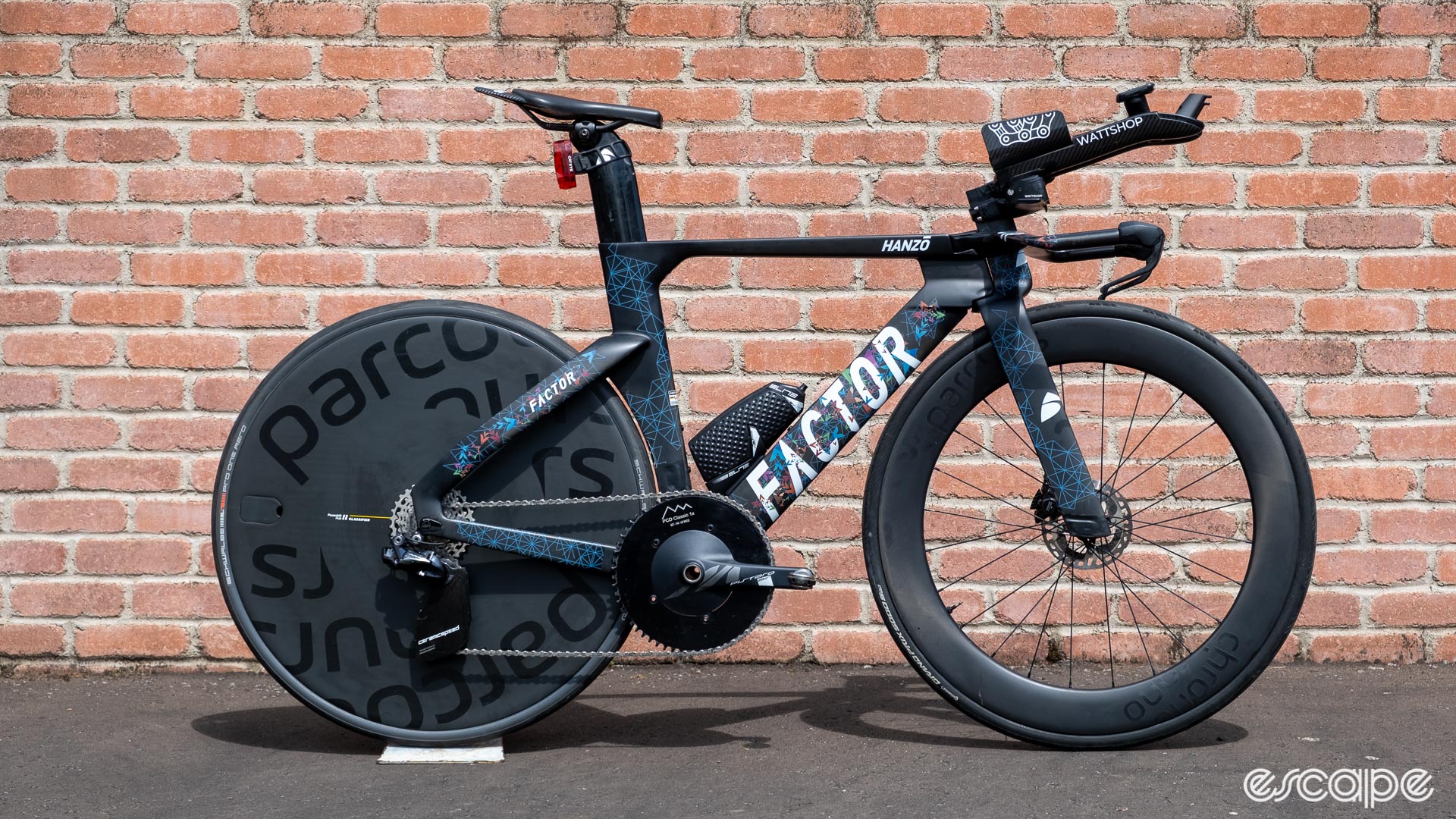
How likely is something to go wrong? Pretty unlikely based on my experience (and, as of this writing, Ganna and Magnus Sheffield sit 1-2 atop the preliminary stage standings, with Thomas yet to finish). I’ve been experimenting with the Classified Powershift in preparation for a few goals I’ve targeted over the past couple of years. At first just asking questions, then with a standard ~60 mm rim, and more recently with the Powershift-compatible Parcours Disc when that was first released last summer.
That disc wheel came too late to optimise my 15-hour time trial Irish end-2-end record, and so the decision was taken to pay a slightly overgeared penalty on the early climbs in order to have an optimal setup for the remaining, mostly flat 500 or so kilometres. But I’ve been training on it quite a bit since in preparation for those other goals.
Apart from those racing on truly hilly, aka sporting, courses, be that time trial or triathlon, it’s in training where I see the benefit for most time trialists. The Classified equipped Parcours disc wheel means I can race and train on the same setup. There are two benefits to this: 1) primarily, I don’t have to spend time on a fiddly 1X to 2X chainring and front derailleur swap between races, and 2) there is the impossible-to-measure but very real benefits of training and getting more accustomed to the exact handling characteristics and speeds of a race-day setup.
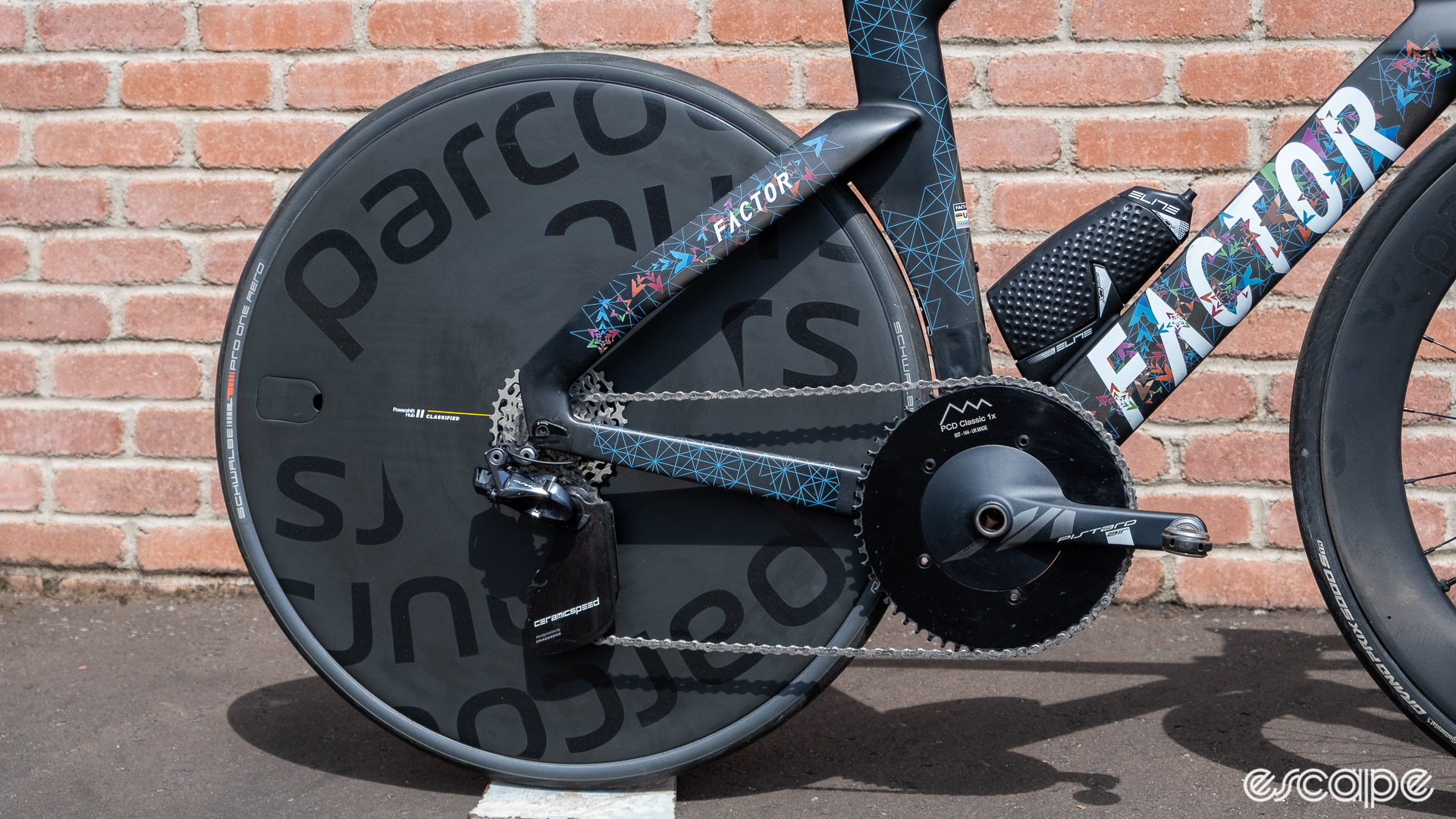
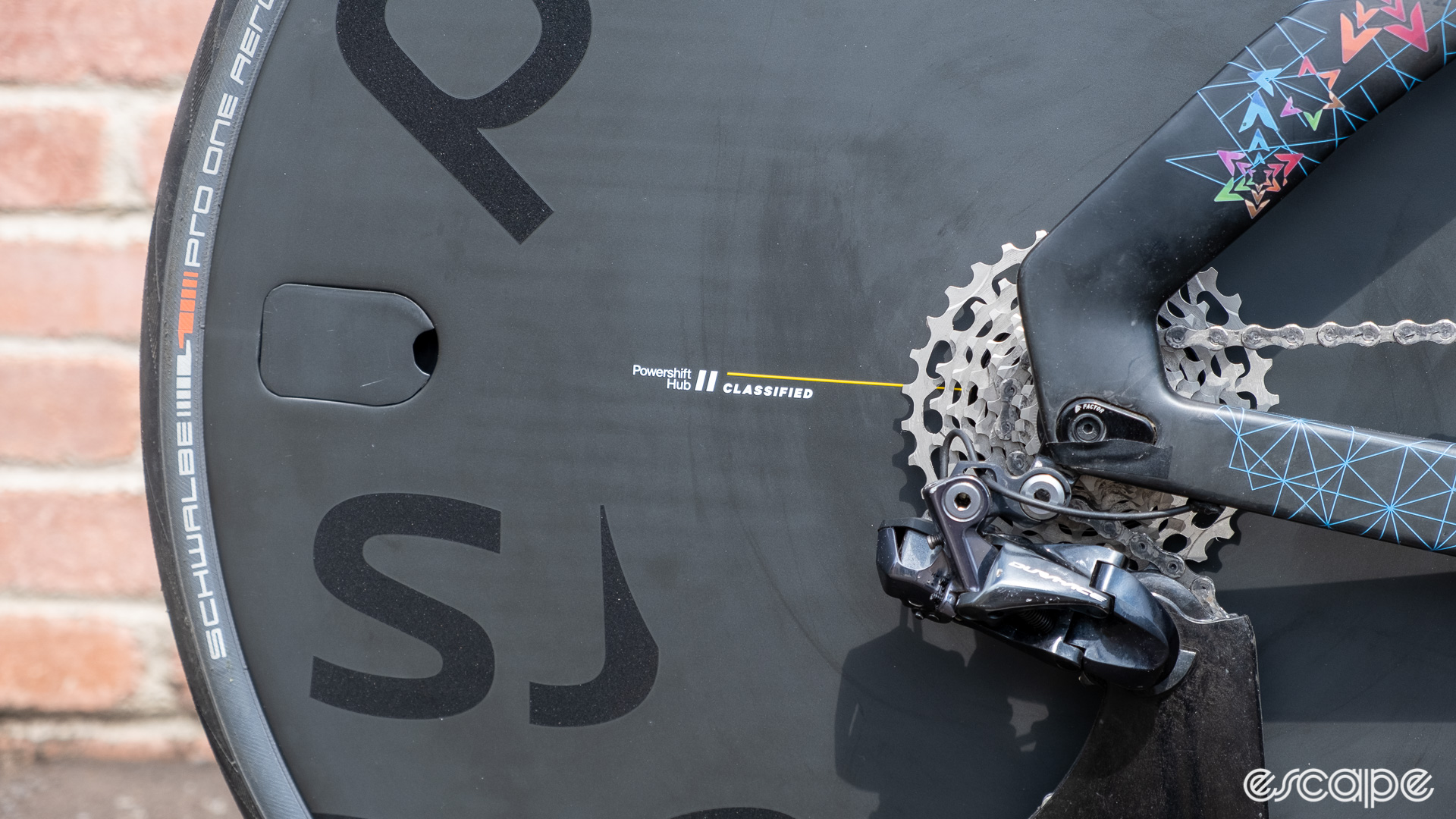
Throughout this time I’ve never once had a dropped chain or any drivetrain issue on the Powershift disc. I’m not using the same PCW disc Ineos are running, but presuming they’ve incorporated it just as well, I don’t envisage any issues there either.
Not having the same disc also makes a weight comparison of the Ineos setup impossible. But looking at the Parcours Disc in both Powershift and standard setups shows a significant weight difference.
The standard disc sans-Powershift weighs 1,240 grams. The standard thru axle, Dura-Ace 11 speed cassette, chainring, and front derailleur comes to a total of 374 grams. All together the 2X setup with Parcours disc weighs 1,613 grams.
Looking at the Powershift Parcours disc, the wheel with Classified hub shell and internals weighs 1,680 grams. The Classified thru-axle, dedicated 11 speed cassette, and shifter button, wire, and control unit weigh a combined 302 grams. Meaning the complete Classified system weighs 1,982 grams. An increase of 300 grams. For what it’s worth, a 300-gram weight gain across the entire course on today’s TT stage would cost the rider around two seconds.
With that in mind, I suspect the question for Ineos was less “Should we run the Classified system?” and more like “Why would we not?” Expect to see much more of it in time trials from here on out.
Update: We put together a quick Performance Process bonus episode after the stage with additional thoughts on the Ineos setup. Performance Process is one of our member-only podcasts, but we're making this episode available to everyone below. If you like what you hear, become a member!
Did we do a good job with this story?

